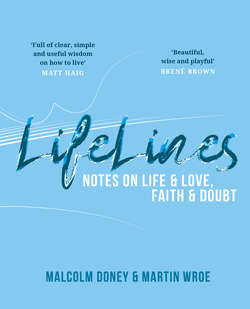Читать книгу LifeLines - Malcolm Doney - Страница 19
На сайте Литреса книга снята с продажи.
Оглавление10
Fear Not.
Fear comes in all shapes and sizes. From whether you can get out of bed and face the day, to whether you can turn off the light and face the night. It’s at the heart of what it means to be human:
The fear of the unknown or of the known.
The fear of not being in control.
The fear of missing out, the fear of taking part.
The fear of loving, the fear of not loving.
The fear of losing love.
The fear of not being good enough.
The fear of someone else – at work or on the street.
The fear of illness, the fear of death.
The fear of never having lived.
We all have fears, however secretly we harbour them. However much we deny them. Maybe it’s some primal survival instinct, the suspicion that we’re never quite safe and secure.
Although we may never be able to banish all our fears, we can make sure they don’t banish us. We don’t have to be managed by fear and insecurity. Of all the phrases in all the books in the Bible, the most common one goes like this: ‘Have no fear.’
Or this: ‘Do Not Be Afraid.’
Fear not. But how?
The Buddhist monk Thich Nhat Hanh says: ‘The only way to ease our fear and be truly happy is to acknowledge our fear and look deeply at its source. Instead of trying to escape from our fear, we can invite it up to our awareness and look at it clearly and deeply.’1
Fear makes us defensive, turns us in on ourselves. It’s opposite is not courage, but love. Love accepts, includes, is symbolised by open arms.
‘There is no fear in love,’ said the early Christian writer John, ‘but perfect love casts out fear.’
There are only two feelings.
Love and fear.
There are only two languages.
Love and fear.
There are only two activities.
Love and fear.
There are only two motives, two procedures, two frameworks, two results.
Love and fear.
Love and fear.2
MICHAEL LEUNIG
